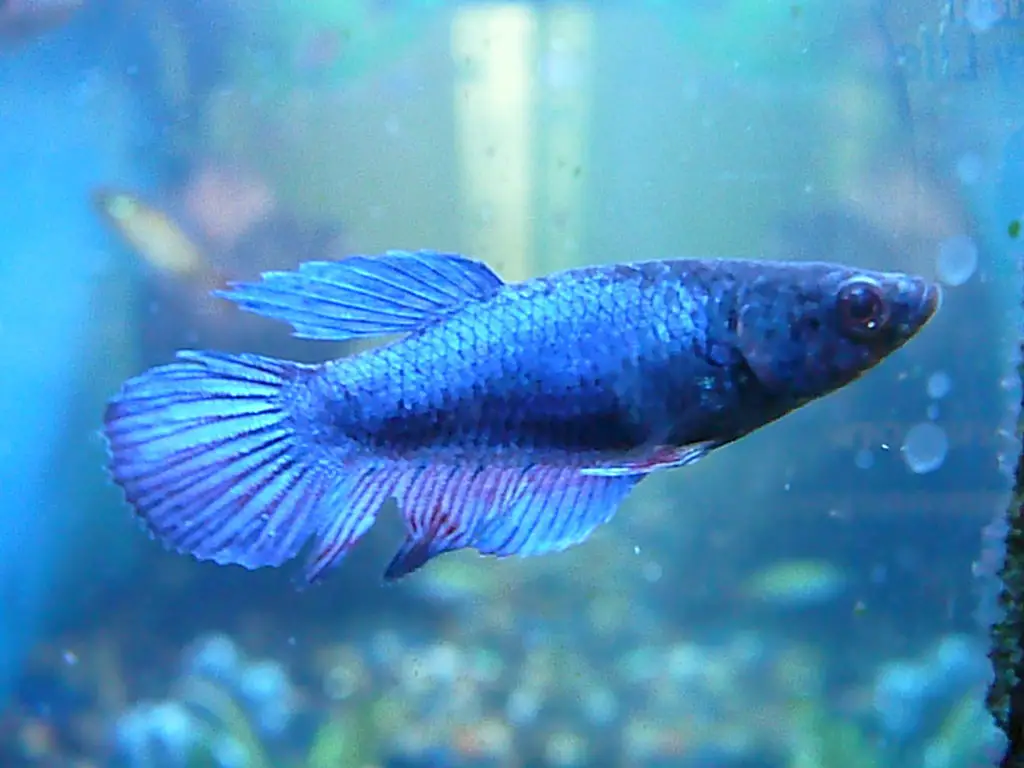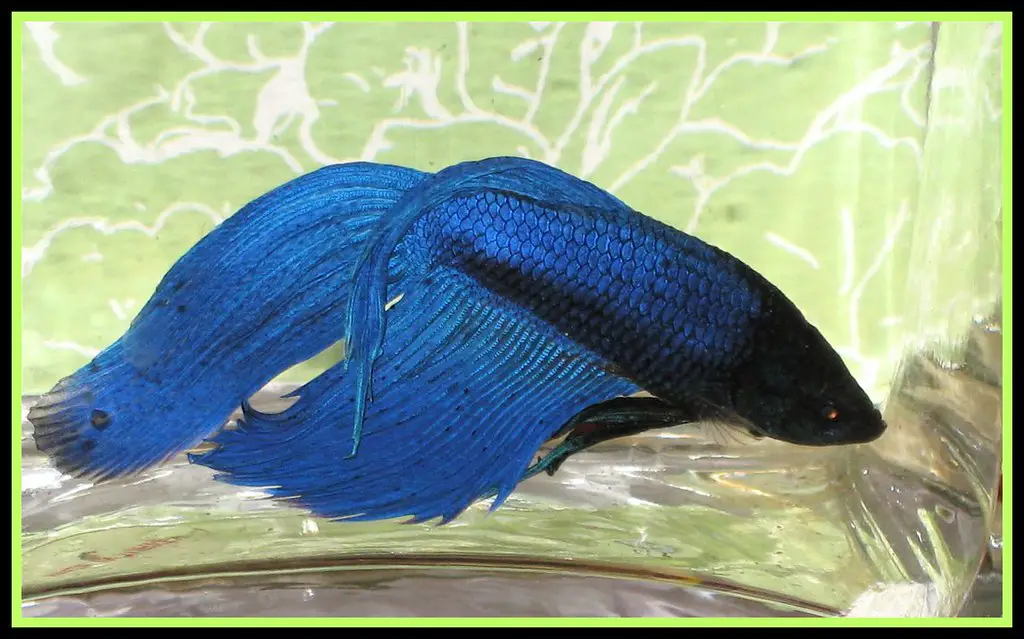The blue betta fish is closely related to a similar species of the red betta fish. It has different colors, but most people call it “blue” because the fins are blue.
Betta fish are popular pets because they are colorful, active, and easy to care for!

Blue Betta Fish
The blue betta fish is one of the most popular aquarium fish in the world. They are easy to keep and enjoy a wide variety of foods, making them a great choice for beginners.
The blue betta is also a peaceful fish and can be kept with other tank mates without problems.

Blue bettas are available in many different colors, including red, yellow, green, black, and silver.
Some people choose to only buy blue bettas because they are so popular, but any of the other colors would be just as happy in an aquarium.
Blue bettas come in different sizes too; some are as small as 4 inches long while others can grow up to 6 inches long.
Blue bettas are lively fish that enjoy swimming around their tank constantly. They will also eat small fishes and invertebrates that swim by.
Because they are such active fish, it is important to provide them with plenty of hiding places where they can rest.
Why are Blue Betta Fish so Popular?
The popularity of the blue betta fish (Pterophyllum scalare) is largely due to its striking coloring and interesting personality.
This small, schooling fish is a natural choice for an aquarium because of its relatively easy care requirements.
A well-maintained blue betta can be a very active member of your home ecosystem, darting back and forth across the tank and engaging in playful activities such as chasing each other or wrestling.

These lively little fish also make great pets for those who are looking for an easygoing addition to their family that doesn’t require a lot of maintenance.
Some of the reasons why blue bettas are so popular include their hardiness, small size, and ability to live in a variety of water conditions including low pH levels.
Blue bettas also have quite a few different color morphs, so there is likely one that will suit your specific needs.
How do you Care for a Blue Betta Fish?
There are many ways to care for a blue betta fish, but the most important thing is to provide clean water and a suitable environment.
A blue betta fish can live in an average home tank, but if you want to keep one as a pet, you will need to purchase a larger tank.
To keep your blue betta healthy, provide them with plenty of fresh water and food. Feed them small prey items such as live insects or small fish.
Do not overfeed them; they will get fat and slow down. If you do overfeed them, remove some of the food afterward so they don’t get too full.
A blue betta fish needs good lighting if you want it to thrive. Provide at least six light fixtures that emit daylight or another light source that your aquarium can tolerate.
Make sure the fixture is covered with plastic so the light doesn’t fall on the water and burn your fish’s eyes.
If possible, place plants in your aquarium to give your betta something to explore and hide under.
What is the Right Temperature for a Blue betta?
A healthy blue betta fish should be kept at a temperature of 76 degrees Fahrenheit. If the water is too cold, the fish will not be able to swim and will become sluggish.
If the water is too warm, the fish will overheat and may die.
Choosing a Betta Fish and Its Food
The blue betta fish, also known as the Siamese fighting fish, is a popular pet in the United States.
It is available in many places where tropical fish are sold, and it can be a bit challenging to find a good one.
Like other tropical fish, bettas need particular types of food to thrive.
Bettas are carnivores and will eat small meaty prey items as well as plant material.
They should have a variety of food options available to them so that they can find what they need to maintain their health and energy levels.
Some basic foods for bettas include flakes, granules or pellets; frozen or live vegetable matter; blood worms; earthworm castings; and live aquatic insects such as crickets or dragonflies.
Breeding of a Blue Betta
The breeding of a blue betta is not difficult and can be fun if done correctly. The most important thing to remember when breeding blue bettas is to keep their water clean and properly aerated.
Bettas are tropical fish, and as such require warm water with a 72-degree temperature. If the water isn’t heated or cooled appropriately, the betta will not breed and may suffer from health problems.
Blue bettas can spawn in both fresh and saltwater setups but prefer soft, acidic water with a pH of 6.0-7.5.
The male will court the female by swimming around her in a figure-eight motion for several minutes before biting her fin in mid-air to deposit his sperm on her pelvic fin.
After spawning, the male will usually leave the area while the female guards their eggs for about 12 hours until they hatch.
During this time, she should be kept in an aquarium with plenty of plants to provide cover and hiding places for the fry.
When hatching occurs, the fry will consume mom’s milk for about two weeks until they become independent enough to eat solid food.
Why is my Blue Betta Fish Turning White?
The blue betta fish, also known as the Siamese fighting fish, is a popular tropical fish. They are colorful and lively, making them perfect for beginner aquarists.
However, like all fish, blue bettas can get sick. White spot disease is one of the most common illnesses in bettas.
White spot disease is a bacterial infection that causes the fish to turn white and develop lesions on their skin.
The disease is spread through contact with infected water or food. Prevention of the disease relies on keeping your betta clean and healthy.
If you do catch white spot disease in your fish, there are treatments available that will help keep them healthy and return them to their normal coloration soon after treatment is completed.
If you notice your fish is turning white and developing lesions, it is important to take them to a certified fish specialist for diagnosis and treatment.
Do Betta Fish like Blue Light?
The short answer is that some betta fish do, while others may not be as keen on the bright blue light. For those fish who do like blue light, it can provide a natural source of swimming inspiration.
Additionally, blue light can stimulate their appetite and help to keep them healthy. However, if your betta fish doesn’t seem to enjoy the bright blue light, don’t force them into it.
There are other ways to encourage their activity and health without exposing them to bright lights.
For those fish who don’t seem to enjoy blue light, there are other ways to stimulate their appetite and health.
Why is my Blue Betta Fish Turning Red?
The blue betta fish is one of the most popular aquarium fish species. They are easy to care for and make an excellent choice for a beginner.
Unfortunately, some blue bettas can develop a condition called “red eye” or erythromelanosis.
The red eye is a disorder that affects the coloration of the skin and sometimes the eyes. The cause is unknown, but it likely results from environmental factors (such as poor water quality) or genetic factors.
Blue bettas with red eyes should be treated immediately by a veterinarian.
If you are concerned about your blue betta fish’s coloration, you can try to treat the disorder using a variety of methods.
If water quality is poor, you can add fresh water and salt to the tank. You can also add special diets or supplements to improve the condition.
If the red eye is due to genetics, there is not much that you can do to cure the fish. However, your veterinarian may be able to offer treatments that will help ease your pet’s symptoms.
Are Blue Betta Fish Rare?
The blue betta fish is one of the more popular freshwater fish in the pet trade. They are easy to care for and make a great addition to any home aquarium.
These fish are not as rare as some people might think, but they are definitely in demand.
The blue betta fish is a beautiful and peaceful fish that can be easily kept in an aquarium of any size.
They prefer cooler water temperatures than other types of fish, so they are perfect for those who live in temperate climates.
The blue betta is also a hardy fish that can survive in slightly brackish water conditions.
If you are looking for a colorful and peaceful addition to your home aquarium, the blue betta is a great option.
How to use Methylene Blue for Betta Fish?
Methylene blue is a medication used to treat a variety of medical conditions. It is also used as an aid in fishkeeping, specifically for betta fish.
To use methylene blue in your tank, first, make sure that you have the correct dosage. You will need to measure out the required amount and add it directly to the water.
Carefully monitor your betta while they are receiving the treatment. If they show any signs of distress or injury, take them out of the tank immediately and seek veterinary help.
Once your betta is stable, you can reintroduce them back into their tank. Be sure to give them time to adjust to their new environment before starting up regular Fishkeeping procedures again.
Methylene blue is a powerful medication, so use caution when using it in your tank. If you do encounter any problems, do not hesitate to contact a veterinarian.
Is Methylene Blue Safe or Betta Fish
Methylene blue is a common and safe treatment for betta fish. It can be used to treat various ailments, including eye infections, red gill disease, and ich.
Methylene blue is also effective in controlling parasites such as neoplasms and flukes.
Be sure to follow the instructions that come with methylene blue treatment products, as improper usage could result in serious harm to your betta fish.
Why Is My Betta Fish Turning Blue?
If you have a betta fish in your aquarium, it is likely that he or she has turned blue.
This effect is caused by a process called chemosis, which is when the fish’s body becomes stimulated to produce too much mucus.
Chemosis can be caused by a variety of things, including changes in water quality and temperature, Parasites, and environmental stressors (like pollution).
The blue coloration usually disappears after 24-48 hours, but it can take up to several weeks for the whole fish to recover fully.
If your betta is displaying other signs of illness (like swimming in circles or not eating), it’s important to get him or her treated as soon as possible.
There are a few things that you can do to help ease your betta fish’s chemosis and help him or her recover more quickly:
1. Improving water quality: Make sure to change your betta’s water often, especially if it’s been showing signs of being polluted. Add a filter to your aquarium if necessary.
2. Adjusting the aquarium temperature: Keeping the aquarium temperature stable is also important for helping your betta fish recover. If you can’t keep the aquarium at a steady temperature, try lowering the water temperature gradually.
3. Providing extra oxygen: Adding an air pump to your aquarium can help increase oxygen levels, which can also help speed up your betta’s healing process.
4. Feeding a high-quality diet: Feed your betta fish a diet that is enriched with antioxidants and other nutrients to help fight off chemosis.
If you still have concerns about your betta fish’s health, please consult a veterinarian.
Why is my Red Betta Fish Turning Blue?
There are a few reasons why red betta fish may turn blue. Could be that they are getting old, could be that they are sick, or could be something as simple as water quality changes.
In many cases, the blue coloration is not permanent and will eventually fade away. However, if the problem is not addressed it can lead to health problems for the fish and even death.
Water Quality
One of the most common reasons betta fish turn blue is due to changes in their water quality.
If their water contains high levels of chlorine or other chemicals, it can cause the fish’s blood to become tinted with these colors.
This can also happen if there is a change in water temperature or pH levels. If you notice your Betta fish turning blue and don’t know what’s causing it, it’s best to get them checked out by a vet.
Old Age
As betta fish get older, they tend to lose some of their red colorations. This happens because they start producing less of the pigment called carotenoids which give their flesh its color.
Over time this process can lead to gradual bluing of the entire body until finally, only the fins remain red.
Sickness
If your Betta fish starts showing signs of illness (such as poor appetite, lethargy, etc.), it’s likely that he has picked up something harmful from his environment and needs treatment ASAP.
If you can’t seem to get your Betta fish to improve even after taking him to a vet, it may be time to give him up.
There are many different types of illnesses that can cause fish to turn blue, and without a proper diagnosis, it’s impossible to know which one is causing the problem.
Water Temperature
If your Betta fish lives in a room that is constantly warm or hot, it may be difficult for him to regulate his body temperature.
This can lead to stress and an increased likelihood of coloration changes. If you’re not sure if your room is too warm or cold, it’s best to check with a thermometer.
PH Levels
One of the most important aspects of caring for a betta fish is maintaining its water’s pH level.
If it becomes too high or low, it can cause a variety of problems for your fish, including coloration changes.
It’s important to always check the pH level of your water and make any necessary changes if needed.
There are many different reasons why your red betta fish may be turning blue, and without a proper diagnosis, it’s impossible to know which one is causing the problem.
If you notice a change in your fish’s coloration, it’s best to get him checked out by a vet.
Can Blue Shrimp Live with Betta Fish?
The betta fish and the blue shrimp are popular pet fish. Both species can live together in a tank, provided there is enough space for both to swim and hide.
However, some precautions should be taken to ensure a harmonious relationship.
Betta fish are tropical fish that originate from Southeast Asia. They are small but lively with an attractive blue and white pattern on their bodies.
They enjoy swimming around in circles or darting about erratically; this is why they are often called “dancing fishes.”
Bettas can get along well with other types of pets such as goldfish, but they may become aggressive if kept with other types of fish that they see as competition for food or territory.
Blue shrimps are small crustaceans that are native to the Americas. They come in different colors including blue, green, red, brown, and black.
Like bettas, shrimps also enjoy swimming around in circles or darting about erratically; however, they prefer to hide under rocks or logs instead of swimming in open water like bettas.
If you’re considering adding a betta fish or blue shrimp to your home aquarium, be sure to read up on each species’ temperament before bringing them home so that you can avoid any potential conflicts.
While both these species can live peacefully together in the right environment, it’s always smart to monitor them closely and remove any potential sources of tension before it escalates into something worse.

